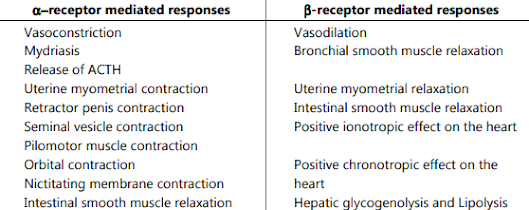When norepinephrine is released from nerve terminals, it interacts with post-synaptic receptor sites to elicit a pharmacological response. In 1948, Ahlquist observed that the tissues he studied included two forms of adrenergic responses, alpha and beta responses, as shown in the table.
With the exception of the last reaction, the table clearly illustrates that -responses are predominantly excitatory in nature, whereas -responses are inhibitory. In general, inhibitory -receptors are activated at far lower catecholamine concentrations than excitatory -receptors.

Similarly, receptors may be divided into α1- and α2-receptors. α1-receptors can be found on the post-synaptic receptor sites of smooth muscles, blood arteries, and gland cells. While α2-receptors are present on nerve terminals in pre- and post-synaptic sites, they are also found in the CNS.
Hypertension is accompanied with an increase in the predominance of 2-receptor responses, which may contribute to the raised blood pressure. The post-synaptic locations of the 2-receptor include tissues such as the brain, uterus, parotid glands, and the extra-synaptic area at certain blood arteries. The nerve terminal contains pre-synaptic 2-receptors. Their activation inhibits neurotransmitter release (norepinephrine or acetylcholine) via a negative feedback inhibitory mechanism. Their role is as follows,
Thus, activation of 2-receptors on cholinergic nerve terminals within the gut wall inhibits acetylcholine release.

Clonidine, yohimbin, and α-methyl-norepinephrine are more potent α2-receptor agonists than α1-receptor agonists. While phenylephrine, prazosin, and methoxamine all have a strong influence on α 1-receptors. Thus, the total impact of adrenergic nerve stimulation in tissues is determined by the number of α and β-receptors present in that organ. In cardiac cells, for example, activation of β -receptors leads in positive ionotropic and positive chronotropic activities, whereas activation of β -receptors results in ectopic excitation generated by sympathetic stimulation.
Further subclassification indicates the existence of four α1 (αA – α1D) and four α2 (αA – α2D) receptors. In the case of β-receptors, the presence of a third (β3) kind is hypothesized. All four α1-receptors induce vasoconstrictor responses via distinct pharmacological pathways that increase cytosolic free Ca++ ions.
Tachyphylaxis, or decreased responsiveness, is a typical side effect of long-term adrenergic medication therapy. Continuous exposure reduces the efficacy of the receptors, resulting in a reduction in the magnitude of the biological reaction. This is referred to as desensitization, refractoriness, downregulation, or tachyphylaxis. Several theories have been proposed for this phenomenon.

With the exception of the last reaction, the table clearly illustrates that -responses are predominantly excitatory in nature, whereas -responses are inhibitory. In general, inhibitory -receptors are activated at far lower catecholamine concentrations than excitatory -receptors.
- β1-receptors, the activation of which causes heart stimulation, lipolysis, and intestinal relaxing effects of sympathomimetic medications.
- β2 -receptors whose activation is responsible for vascular bed, bronchial tree, uterus, and ureter relaxation, as well as the metabolic effects of sympathomimetic medications.
Similarly, receptors may be divided into α1- and α2-receptors. α1-receptors can be found on the post-synaptic receptor sites of smooth muscles, blood arteries, and gland cells. While α2-receptors are present on nerve terminals in pre- and post-synaptic sites, they are also found in the CNS.
Hypertension is accompanied with an increase in the predominance of 2-receptor responses, which may contribute to the raised blood pressure. The post-synaptic locations of the 2-receptor include tissues such as the brain, uterus, parotid glands, and the extra-synaptic area at certain blood arteries. The nerve terminal contains pre-synaptic 2-receptors. Their activation inhibits neurotransmitter release (norepinephrine or acetylcholine) via a negative feedback inhibitory mechanism. Their role is as follows,
- to control neurotransmitter release
- can change the pace of neurotransmitter production as needed
Thus, activation of 2-receptors on cholinergic nerve terminals within the gut wall inhibits acetylcholine release.
Clonidine, yohimbin, and α-methyl-norepinephrine are more potent α2-receptor agonists than α1-receptor agonists. While phenylephrine, prazosin, and methoxamine all have a strong influence on α 1-receptors. Thus, the total impact of adrenergic nerve stimulation in tissues is determined by the number of α and β-receptors present in that organ. In cardiac cells, for example, activation of β -receptors leads in positive ionotropic and positive chronotropic activities, whereas activation of β -receptors results in ectopic excitation generated by sympathetic stimulation.
Further subclassification indicates the existence of four α1 (αA – α1D) and four α2 (αA – α2D) receptors. In the case of β-receptors, the presence of a third (β3) kind is hypothesized. All four α1-receptors induce vasoconstrictor responses via distinct pharmacological pathways that increase cytosolic free Ca++ ions.
Tachyphylaxis, or decreased responsiveness, is a typical side effect of long-term adrenergic medication therapy. Continuous exposure reduces the efficacy of the receptors, resulting in a reduction in the magnitude of the biological reaction. This is referred to as desensitization, refractoriness, downregulation, or tachyphylaxis. Several theories have been proposed for this phenomenon.
Get subject wise printable pdf notesView Here



No comments:
Post a Comment
Please don't spam. Comments having links would not be published.